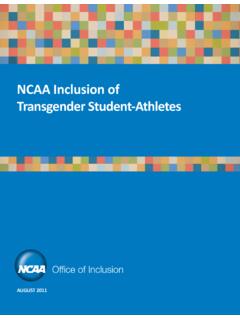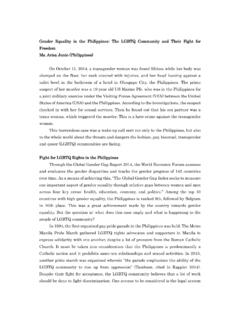Transcription of Structural and Social Determinants of Health (SSDHs)
1 1 Structural and Social Determinants of Health (SSDHs)What are Structural and Social Determinants of Health ? Basic definitions (and why SSDHs matter)From the Centers of Disease Control and Prevention (CDC): The complex, integrated, and overlapping Social structures and economic systems that are responsible for most Health inequities. These Social structures and economic systems include the Social environment, physical environment, Health services, and Structural and societal factors. Social Determinants of Health are shaped by the distribution of money, power, and resources throughout local communities, nations, and the world.
2 ( ) From the World Health Organization: Many factors combine together to affect the Health of individuals and communities. Whether people are healthy or not, is determined by their circumstances and environment. To a large extent, factors such as where we live, the state of our environment, genetics, our income and education level, and our relationships with friends and family all have considerable impacts on context of people s lives determine their Health , and so blaming individuals for having poor Health or crediting them for good Health is inappropriate.
3 Individuals are unlikely to be able to directly control many of the Determinants of Health . ( ) Where most US public Health interventions focus on individual knowledge and behaviors, SSDHs look at the broader example: getting to the gym moreOur intervention options under an individual/behavioral focus:3 Do nothing 3 Positive messaging (Michelle Obama s Let s Move Campaign)3 Negative messaging (scare someone about diseases, shame their current body shape)3 Increasing knowledge (information on accessing the gym, how to exercise, the effects on Health )3 Offer benefits/incentives (free training services, financial incentives via insurance, discounts/rebates)3 Create consequences (insurance penalties)What if there are Structural barriers?
4 3 The gym is very far and there s no public transit3 The gym is really expensive3 The gym equipment is old and dangerous3 Signs/services are all in a language someone doesn t know3 Gym hours are too early/lateWhat if there are Social barriers? 3 The gym staff is really bitter and meanThe context of people s lives determine their Health , and so blaming individuals for having poor Health or crediting them for good Health is inappropriate. Structural and Social Determinants of Health (SSDHs) 23 People make fun of someone or insult them3 Someone doesn t feel like they fit in with other people at the gymWhat if there are other personal barriers?
5 3 Joint pain and no insurance/doctor to help3 Need assistance with mental Health issues (depression, anxiety disorder, history of trauma)3 Need help addressing alcohol or drug use3 Too busy trying to meet basic needs (housing, food, safety)Conclusion: No matter how empowered or knowledgeable someone is, no matter how much they may want to change their behavior, they won t be able to get to the gym unless we address these other issues. The same goes for HIV prevention. We do a disservice to our communities by only focusing on behavioral change and education and ignoring Structural , Social , and other personal barriers.
6 HIV prevention interventions must be about more than education and behavior change! We will not end the epidemic with new Social media campaigns and behavioral counseling alone; we must address local, state, and national policies. Nine common Structural and Social barriers (and areas for policy advocacy)To maximize HIV prevention efforts in the United States, there are a number of key policies and laws that we would need to change. Here are some priority areas, in no particular order, that are of immediate importance for HIV prevention policy advocates.
7 1. Criminalization of HIVThe problem. The majority of states have some form of HIV-specific law that criminalizes HIV transmission or the possibility of HIV transmission. Many of these laws do not take into account new advancements in HIV prevention such as treatment as prevention (TasP) and pre-exposure prophylaxis (PrEP) and criminalize behaviors that cannot transmit HIV, such as biting and spitting. In many other states, other laws, such as assault or attempted murder, have been used to prosecute people living with HIV.
8 Many times these laws are applied in cases where transmission wasn t even possible. Criminal disclosure laws place an undue burden on people living with HIV in communities and situations where it is dangerous to talk about one s HIV status. The modernization or possible repeal of such laws is a priority for prevention advocates. There is no proof that such laws stop any forward HIV transmission, but many experts believe that such laws could have a significant chilling effect on testing efforts. More research needs to be done, but at least one study out of Canada found that 17% of a high-risk cohort of men who have sex with men (MSM) said that criminalization laws affected their willingness to get tested for of policies to target: 3 State laws criminalizing HIV transmission in some way here is a compilation of criminal laws by state provided by the Center for HIV Law and Policy (through May 2015): 3 The CDC also has a complete list: )National organizations to connect with.
9 Fortunately, there are a number of amazing criminalization activists working on these laws at the state and national levels: 3 The SeroProject listserv is a great way to keep up on ongoing discussions. 3 The Center for HIV Law and Policy ( ) is another great organization leading the fight on these Criminalization of marginalized populationsThe problem. The United States locks up around 2% of its adult population; around one in nine American men and one in 56 American women is likely to spend time in prison in their lifetimes.
10 One in three Black men and one in six Latino men are likely to spend time in prison in their lifetimes, as compared to one in 17 white men. This racial disparity also exists for women while one in 111 white women will spend time in prison, for Latina women this likelihood is increased HIV prevention interventions must be about more than education and behavior change! Structural and Social Determinants of Health (SSDHs) 3to one in 45 and for Black women one in 18. LGBTQ populations are also disproportionally impacted by mass incarceration, particularly for transgender populations.




